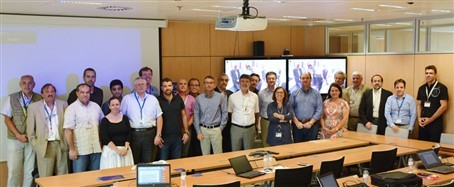Turning point for European Test Blanket Module Systems


ITER will give a one-of-a kind opportunity to different scientists around the world to test a range of technologies in unprecedented conditions. Without a doubt, the lessons drawn will have significant implications towards the design of future fusion reactors like DEMO. Experts working in the area of Test Blanket Modules Systems (TBMS) are among those who will use ITER to figure out how tritium can be continuously bred in order to keep the fusion reaction going. In essence, they will be generating a new nuclear system and licensing it using advanced materials and top fabrication techniques.
Europe has developed two blanket concepts: the Helium-Cooled Pebble-Bed (HCPB) and the Helium-Cooled Lead Lithium (HCLL). The key difference lies in the type of materials used for the tritium breeder. In order to choose which way to go for DEMO, it has been decided to test both European concepts simultaneously in ITER by placing the TBMS in an equatorial port of the machine. Under the leadership of F4E, companies like IDOM, Atmostat, AMEC Foster Wheeler, Empresarios Agrupados, Assystem, Iberdrola, and European fusion laboratories such as KIT, CEA, ENEA, CIEMAT, UJV, KFKI, NRG, have been collaborating extensively to push the R&D frontiers further.
Years of hard work and a documentation exceeding 1 500 pages of engineering reports have come to crunch during the Conceptual Design Review (CDR) meeting, organised jointly by F4E and ITER International Organization on 8-12 June in Barcelona, gathering 30 distinguished experts from this field in order to review and assess the progress so far. In a nutshell, the main objectives of the meeting were to check how the requirements of the systems have been properly taken into account in the design, how risks have been taken into consideration and have been minimised, and whether all boundaries of the system in ITER have been established and secured. For Yves Poitevin, F4E’s Project Manager for European TBMS, and his team, “this has been a turning point for the field because years of R&D work have taken shape and evolved into an engineering design that one day will be a system in ITER” he explains.
The assessment of the CDR panel was overall positive praising the high quality of work and making some recommendations. This has been a big deal for those involved in this system the last 15 years, witnessing its transformation from the early concepts elaborated in European fusion laboratories to engineering design and standardised manufacturing procedures developed in collaboration with industry.